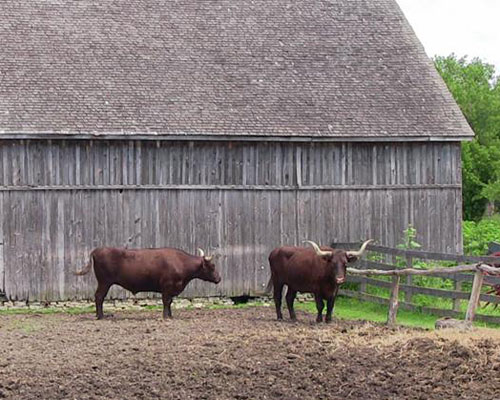Garfield Farm's Java breeding program was responsible for re-discovering the White and Auburn Javas, varieties that had been lost to neglect. They also keep Narragansett turkeys and other heritage breed livestock.
This is always a terrific event for poultry. Bring birds to show and sell, or come and admire them.
From the web site:
Garfield
Farm Museum holds its annual rare breeds livestock and
poultry show each May. The only show of its type held
in Illinois, looks at the loss of genetic diversity amongst
domestic animals that humans have depended upon for food,
fiber, and work for hundreds of years. For many visitors to
the show it is the first and perhaps last time in their
lives they might ever see some of these highly endangered
breeds.
In
today's market, very few breeds are used in modern farms.
Those that are tend to have very small gene pools as
artificial insemination makes it possible for one prized
male animal to father thousands of offspring. This leads to
a lack of genetic diversity. Genetic resistance or hardiness
to disease might be absent in such a line. A disease could
strike that could eliminate such a breed. Breed diversity is
not only a novelty, it is a necessity.
 |
In times of economic uncertainty like the one we are in, any
threat to our food sources could be disastrous. Should a
disease or other factor make the breeds currently used not
viable, food would become harder and more expensive to come
by. What genetic diversity does is provide the option of a
different genetic strain that may not be affected by the
same things as the modern commonplace strain. Should the
currently used breed be effected the heritage breed may not.
There
is also the matter of taste. Many of the currently used
animals are used because they can grow to a desired size in
a relatively short amount of time. Some older breeds may
take longer to reach maturity, but they have a flavor to
their meat or eggs that is missing in the genetically narrow
market.
Breeders
are invited to exhibit their animals at the museum with a
chance to meet other breeders and prospective buyers. Pens,
water, and bedding are provided by the museum just bring
feed and any information, displays, products,
demonstrations, or lectures related to the breeds being
shown. There are no registration fees for exhibitors.
Exhibitors must have appropriate health paperwork on their
animals.
In addition to seeing the animals, visitors and exhibitors can tour the 1846 Teamster Inn and Tavern, watch demonstrations of sheep shearing, wool spinning, or enjoy refreshments.
In addition to seeing the animals, visitors and exhibitors can tour the 1846 Teamster Inn and Tavern, watch demonstrations of sheep shearing, wool spinning, or enjoy refreshments.

.jpg)

No comments:
Post a Comment